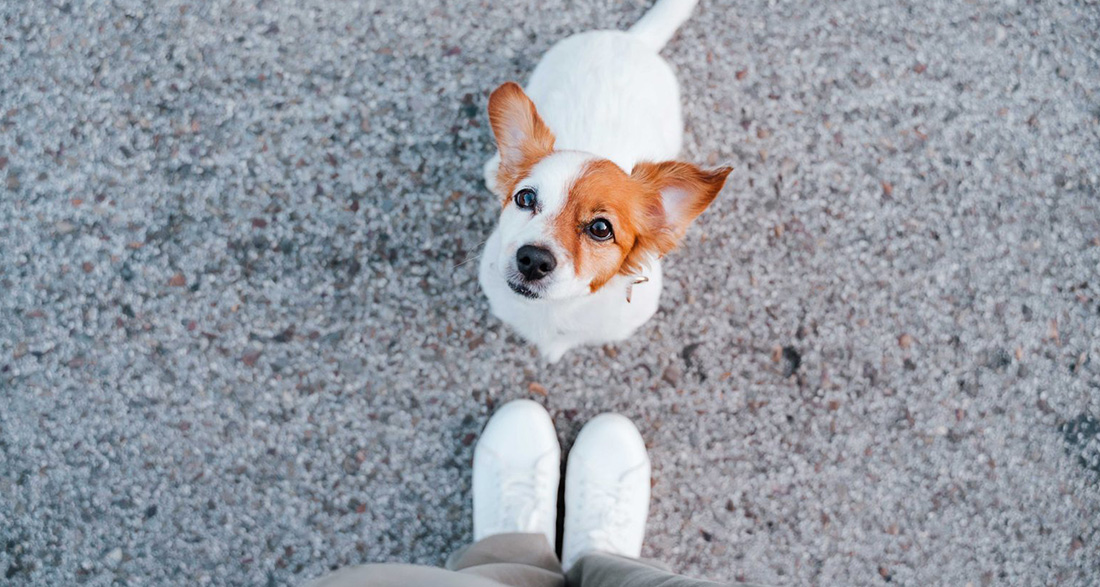Which dogs can learn Paw on Foot?
This trick is generally enjoyable for most dogs. However, it might be more challenging with larger dogs. The dog stands underneath or between the person’s legs, facing the same direction, and is supposed to place its front paws on the human’s feet. Professionals can later attempt a few steps together. For the “Paw on Foot” trick, it’s very helpful if your dog already knows the “Shake” trick.
How do I teach my dog Paw on Foot?
The clicker is a useful training tool for this trick, as it makes precise reinforcement easier. If you haven’t worked with a clicker before, conditioning is necessary. Take some treats, sit next to your furry friend, and use the clicker. After the “click,” immediately give your dog a treat. Repeat this until you are sure your dog understands that the click sound is something wonderful, followed by a treat. Later, only click when your dog shows the desired behavior, and simply ignore undesired behavior.
Step 1
Go to a quiet room with your dog to minimize distractions. Have training treats ready. First, lure your dog from behind through your legs so that it stands directly under you. Then click and give your dog the treat. Repeat this process, but wait a bit longer each time before clicking and rewarding. Occasionally, touch your dog lightly with your legs (preferably while it’s taking the treat) to show that body contact in this position is not a problem.
Step 2
If your dog has no issue positioning itself under you and waiting there, proceed with placing its paws. Start with one paw and focus on that paw during each repetition. It’s crucial that your dog can already confidently give its paw. Hold your flat hand over your foot and request your dog to place its paw in it. If it does, click, and the reward follows immediately. In the next repetition, just before the paw touches your hand, pull it away, so the paw lands on your foot – excellent! Click immediately and give two or three treats calmly.
Now, practice this step repeatedly until your dog, on your cue, places its paw on your foot. Note that many dogs might back away if you lean over them to position your hand above your foot. In this case, you can work with a Post-it as a target. Your dog needs to be familiar with a target beforehand. Stick a Post-it on your foot and let the dog place its paw on it. When it does, click and reward. Later, sneak away the Post-it.
Step 3
The main part is done; your dog places its paw on your foot and waits for you to click and receive its reward. Now, repeat this process with the other side in the same way. Either use your hand or another Post-it, possibly in a different color. Once the second paw also lands on your foot on cue, try combining both so your dog puts a paw on each foot.
Only introduce the verbal cue when the fine goal is achieved, and the dog understands the sequence of actions (placing both paws on your feet). Shortly before gesturing, give the verbal cue, like “Foot” or a similarly fitting word. Ensure you don’t place your feet too far apart to avoid making it difficult for your dog. If it works, it’s a jackpot for your furry friend! Then, follow up with several repetitions so your dog becomes more confident, and you can gradually reduce your gesture.
Then, try gently wiggling your feet and reward your dog if it stays put instead of jumping off. This way, you gradually move toward the first real step forward, where your dog should also remain on your feet. After many regular repetitions, your dog will understand that the key is to keep its paws on your feet at all costs to receive praise and treats. Soon, you’ll achieve several steps together, both forward and backward.
Tip:
The choice of shoes can make a difference. If your dog slips off your smooth leather shoes, it might find the task uncomfortable. Socks can already make the exercise more pleasant.
If the second step with giving the paw doesn’t go quite right, you can alternatively lure your dog forward onto your feet with a treat, which you’ve placed the tips of your toes together. If the paw accidentally lands on your foot, celebrate your dog enthusiastically (don’t forget to click and treat here).
Short and regular training sessions are more effective than longer ones. And of course, with “Paw on Foot,” like any trick, the focus should be on fun and shared time.


